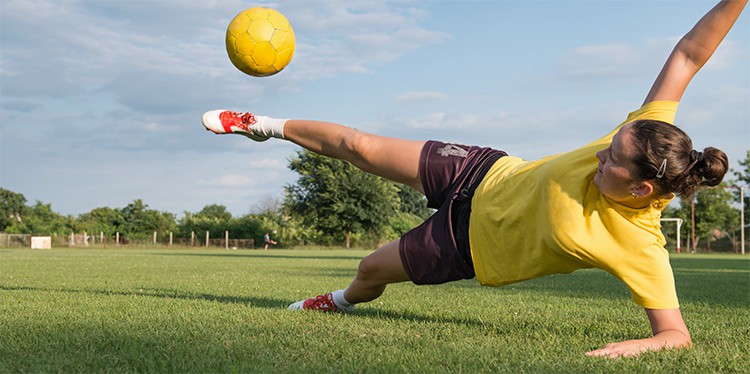Brain injury research on concussions leads to neck strengthening in young athletes

Increased public awareness of the potential consequences of concussion has raised concern about the safety of youth sports. While football, hockey, and other predominantly male contact sports capture much of the media attention about concussions, females are uniquely at risk and report a higher duration and severity of concussion symptoms after an injury. Recent studies indicate that when boys and girls play the same sport – such as hockey or soccer, girls have a higher incidence of concussion.
A key reason for this higher rate in girls is attributed to the fact that girls’ necks tend to be smaller and have weaker muscles than boys. A blow to the head results in more trauma with a smaller (therefore weaker) neck. This is because the head, when it receives a blow, accelerates more, along with the brain. “It’s affecting their head more, changing the acceleration on the head, more than a boy’s head,” says Dr. Uzma Samadani, director of the Brain Injury Research Lab at HCMC.
The lab is working with six metro high school athletic programs and one college to see if neck strengthening will help reduce concussion incidence, duration, and severity. It starts with a baseline assessment of both male and female athletes who are then asked to perform specific, manually-resisted neck strengthening sessions twice per week. Subjects are routinely re-evaluated and followed to record the incidence of concussion. To assess the severity and length of concussions, subjects are tested using the SCAT5 concussion assessment, a new tool designed to better evaluate suspected concussions quickly and accurately. This tool cannot diagnose a concussion but does give valuable information to help with a physician’s diagnosis.
The lab is collaborating with Dr JT Eckner, a physician from the University of Michigan who helped develop the neck strengthening protocol. The study hopes to validate that a stronger neck will prevent concussions and decrease their severity, as well as help define which exact muscles are key and provide the most benefit from strengthening.
Neck strengthening is a good idea for not only athletes but probably all of society – in fact, falls are the leading cause of traumatic brain injury and concussions. In addition neck strengthening may potentially reduce the long-term risks of other problems – such as degenerative spine disease resulting in a forward bend as a person ages. Students using cell phones and tablets may be particularly at risk for such conditions.
“If our research demonstrates that neck strengthening reduces the consequences of a head impact, maybe everyone can benefit from neck strengthening for concussion prevention,” says Joe Toninato, Research Assistant for the Brain Injury Research Lab. “This is something that could be incorporated into physical education classes for children.”

